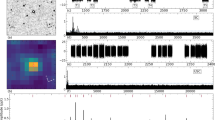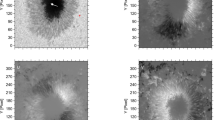Abstract
New polarization observations of the subdwarf Bal 09 are analyzed. Bal 09 belongs to the group of hybrid sdB stars, which display both short- and long-period pulsations. Explaining certain properties of Bal 09 that were previously unknown in relation to subdwarfs (variations of the amplitude of the fundamental pulsation mode, rotational splitting of line multiplets and variation of this splitting) requires invoking information about the magnetic field of the star. According to estimates made in 2010, the longitudinal component of the magnetic field of Bal 09 is 34±63 G. This value is significantly lower than the fields found earlier for six other hot subdwarfs. New observational data for the longitudinal magnetic field of Bal 09 was obtained on July 27, 2012, using the main stellar spectrograph of the 6-m telescope of the Special Astrophysical Observatory (SAO). The longitudinal component of the magnetic field 〈B z 〉 was found via a regression analysis. When applied to the star HD 210762 with a zero total magnetic field, this method yielded the value 〈B z 〉 = −12 ± 9 G. The observations also included measurements of 〈B z 〉 for the well-studied magnetic star γ Equ, which is used at the SAO for calibration and testing of the polarimetric instruments. The estimate obtained for γ Equ is 〈B z 〉 = −546±16G, consistentwith the general variations of the longitudinal magnetic-field component of this star. This new study, based on data obtained on July 27, 2012, leads to a similar estimate of the longitudinal magnetic field, 〈B z 〉 = −23±53 G. This estimate of 〈B z 〉 was obtained for the full analyzed spectral range (4400–4958 Å). The corresponding “limited” solution yielded −32±63 G. The regression analysis for the individual spectral sub-bands and for bands containing characteristic spectral features, did not provide firm evidence of the presence of a magnetic field, with a strength exceeding the error in 〈B z 〉. The data analysis leads to the conclusion that the errors of the measurements made in 2010 and 2012 are in good agreement. This testifies to the reliability of the method applied and of the resulting observational material. In addition, the estimates are in good agreement among themselves and with estimates obtained earlier, in 2010. The results unambiguously confirm the earlier conclusion that the subdwarf Bal 09 does not have magnetic field with a strength comparable to those detected earlier for six sdB and sdO stars. Estimates of 〈B z 〉 for hot subdwarfs that have appeared in the literature since the 2010 study also provide trustworthy evidence for the absence of magnetic fields ∼ 1 kG in these objects.
Similar content being viewed by others
References
I. S. Savanov, I. I. Romanyuk, E. A. Semenko, and E. S. Dmitrienko, Astron. Rep. 55, 1115 (2011).
S. J. O’Toole, S. Jordan, S. Friedrich, et al., Astron. Astrophys. 437, 227 (2005).
V. Elkin, Astron. Astrophys. 312, L5 (1996).
G. A. Chountonov, in Magnetic Stars, Ed. by Yu. Glagolevskij, D. Kudryavtsev, and I. Romanyuk (SAO RAN, Nizhnii Arkhyz, 2004), p. 286.
D. O. Kudryavtsev, Baltic Astron. 9, 649 (2000).
J. D. Landstreet, Astrophys. J. 258, 639 (1982).
S. Bagnulo, T. Szeifert, G. A. Wade, et al., Astron. Astrophys. 389, 191 (2002).
J. L. Leroy, S. Bagnulo, M. Landolfi, et al., Astron. Astrophys. 284, 174 (1994).
A. Baran, R. Oreiro, A. Pigulski, et al., Mon. Not. R. Astron. Soc. 392, 1092 (2009).
R. Howe, Adv. Space Res. 41, 846 (2008).
P. R. Goode and W. A. Dziembowski, Nature 349, 223 (1991).
J. D. Landstreet, S. Bagnulo and L. Fossati, et al., Astron. Astrophys. 541, A100 (2012).
G. Mathys, S. Hubrig, E. Mason, et al., Astron. Nachr. 88, 1 (2010).
E. F. Borra, J. D. Landstreet, and I. Thompson, Astrophys. J. Suppl. Ser. 53, 151 (1983).
P. Petit, V. van Grootel, S. Bagnulo, et al., in Fifth Meeting on Hot Subdwarf Stars and Related Objects, Ed. by D. Kilkenny, C. Simon Jeffery and Chris Koen, ASP Conf. Ser. 452, 257 (2012); arXiv:1110.5227 [astro-ph] (2011).
F. Leone, M. J. Martinez Gonzalez, R. L. M. Corradi, et al., Astrophys. J. Lett. 731, L33 (2011).
S. Jordan, K. Werner, and S. J. O’Toole, Astron. Astrophys. 432, 273 (2005).
Author information
Authors and Affiliations
Corresponding author
Additional information
Original Russian Text © I.S. Savanov, I.I. Romaniuk, E.A. Semenko, E.S. Dmitrienko, 2013, published in Astronomicheskii Zhurnal, 2013, Vol. 90, No. 10, pp. 819–825.
Rights and permissions
About this article
Cite this article
Savanov, I.S., Romaniuk, I.I., Semenko, E.A. et al. The presence of a magnetic field on the pulsating subdwarf Balloon 090100001. Observations of 2012. Astron. Rep. 57, 751–756 (2013). https://doi.org/10.1134/S1063772913090059
Received:
Accepted:
Published:
Issue Date:
DOI: https://doi.org/10.1134/S1063772913090059




